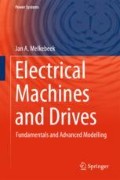Abstract
With the advent of variable frequency supply of rotating field machines in the second half of the twentieth century, some cases of hunting of induction machines fed with a low frequency supply became apparent. This was the starting point of research into the causes of these instabilities. In this chapter we analyse the stability behaviour of induction machine drives for variable frequency supply. A traditional model with constant saturation is used to analyse the dynamic behaviour. Using well-chosen dimensionless parameters, the characteristic dynamic behaviour of induction machines can be represented in a handy way. Because induction machines obey scaling laws quite narrowly, it is possible to predict the dynamic behaviour of a typical machine.
Access this chapter
Tax calculation will be finalised at checkout
Purchases are for personal use only
Notes
- 1.
It can be shown that a rotor cage can always be replaced by an equivalent three-phase sinusoidally distributed rotor winding.
- 2.
However, the model can also be derived using the complex time phasors (see below).
- 3.
In fact, this transformation yields the usual zero-sequence, positive and negative sequence components when the inputs are the phasors or time phasors of the voltages or currents. We apply it here to the real-time functions, and the resulting components are not the symmetrical components as usually defined. However, the space vectors we will derive afterwards will be identical (see also Appendix C).
- 4.
Check also \(\mathbf {(T_{s}^{-1}}\mathbf {R}\mathbf {T_{s}})^{+}\equiv \mathbf {T_{s}^{-1}}\mathbf {R}\mathbf {T_{s}}\) and \(\mathbf {(T_{s}^{-1}}\mathbf {L}\mathbf {T_{s}})^{+}\equiv \mathbf {T_{s}^{-1}}\mathbf {L}\mathbf {T_{s}}\).
- 5.
The reason for this is that a relatively high air-gap induction is required to obtain a sufficient power output for a given machine size.
- 6.
Another problem with self-excitation is that a model with only the chord-slope inductance will create two degrees of freedom (i.e. two eigenvalues on the imaginary axis) for the self-excitation, which does not exist in real life.
- 7.
Please explain why \(F_{vy}(p)\) is proportional to \(pF_{\nu }(p)\).
- 8.
Explain this. Keep in mind the chosen (instantaneously) synchronous reference frame.
- 9.
There are an infinite number of worst damping lines, depending on how the concept is defined, for example for constant \(\tau _{r}/\tau _{m}\) or for constant \(\nu _{0}\tau _{r}\). Explain this from a purely mathematical point of view, and think of partial derivatives. In fact, the worst damping line for constant \(\tau _{r}/\tau _{m}\) and variable \(\nu _{0}\tau _{r}\) is somewhat more practical, but the difference between both lines is small.
- 10.
On a laboratory setting, it is not possible to demonstrate the instability for large machines as the maximum power rating in most laboratories is too low. An artificial way of demonstrating instability of induction machines is to use machines with a lower power rating and to compensate the stabilising effect of \(\sigma \) by artificially increasing the damping ratio by means of additional line resistances.
Author information
Authors and Affiliations
Corresponding author
Rights and permissions
Copyright information
© 2018 Springer International Publishing AG
About this chapter
Cite this chapter
Melkebeek, J.A. (2018). Modelling and Dynamic Behaviour of Induction Machines. In: Electrical Machines and Drives. Power Systems. Springer, Cham. https://doi.org/10.1007/978-3-319-72730-1_27
Download citation
DOI: https://doi.org/10.1007/978-3-319-72730-1_27
Published:
Publisher Name: Springer, Cham
Print ISBN: 978-3-319-72729-5
Online ISBN: 978-3-319-72730-1
eBook Packages: EnergyEnergy (R0)

